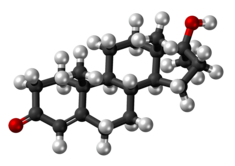
Back ميثيل تستوستيرون Arabic متیل تستوسترون AZB Methyltestosteron Welsh Methyltestosteron German متیلتستوسترون Persian Մեթիլտեստաստերոն Armenian Metiltestosterone Italian Metiltestosterons Latvian/Lettish Metiltestosteron Malay Metyltestosteron NB
 | |
 | |
| Clinical data | |
|---|---|
| Trade names | Agoviron, Android, Metandren, Oraviron, Oreton, Testovis, Testred, Virilon, others |
| Other names | RU-24400; NSC-9701; 17α-Methyltestosterone; 17α-Methylandrost-4-en-17β-ol-3-one[1][2][3] |
| AHFS/Drugs.com | Monograph |
| Pregnancy category |
|
| Routes of administration | By mouth, buccal, sublingual[4][5][6] |
| Drug class | Androgen; Anabolic steroid |
| ATC code | |
| Legal status | |
| Legal status |
|
| Pharmacokinetic data | |
| Bioavailability | ~70%[8] |
| Protein binding | 98%[9] |
| Metabolism | Liver |
| Elimination half-life | 150 minutes (~2.5–3 hours)[8][10] |
| Duration of action | 1–3 days[9] |
| Excretion | Urine: 90%[9] Feces: 6%[9][11] |
| Identifiers | |
| |
| CAS Number | |
| PubChem CID | |
| IUPHAR/BPS | |
| DrugBank | |
| ChemSpider | |
| UNII | |
| KEGG | |
| ChEBI | |
| ChEMBL | |
| CompTox Dashboard (EPA) | |
| ECHA InfoCard | 100.000.333 |
| Chemical and physical data | |
| Formula | C20H30O2 |
| Molar mass | 302.458 g·mol−1 |
| 3D model (JSmol) | |
| |
| |
| (verify) | |
Methyltestosterone, sold under the brand names Android, Metandren, and Testred among others, is an androgen and anabolic steroid (AAS) medication which is used in the treatment of low testosterone levels in men, delayed puberty in boys, at low doses as a component of menopausal hormone therapy for menopausal symptoms like hot flashes, osteoporosis, and low sexual desire in women, and to treat breast cancer in women.[4][5][12][13][14] It is taken by mouth or held in the cheek or under the tongue.[4][13][14][6]
Side effects of methyltestosterone include symptoms of masculinization like acne, increased hair growth, voice changes, and increased sexual desire.[4] It can also cause estrogenic effects like fluid retention, breast tenderness, and breast enlargement in men and liver damage.[4] The drug is a synthetic androgen and anabolic steroid and hence is an agonist of the androgen receptor (AR), the biological target of androgens like testosterone and dihydrotestosterone (DHT).[4][15] It has moderate androgenic effects and moderate anabolic effects, which make it useful for producing masculinization.[4][16]
Methyltestosterone was discovered in 1935 and was introduced for medical use in 1936.[6][17][18][19][4] It was made shortly after the discovery of testosterone and was one of the first synthetic AAS to be developed.[6][17][18] In addition to its medical use, methyltestosterone is used to improve physique and performance, although it is not as commonly used as other AAS for such purposes due to its androgenic effects, estrogenic effects, and risk of liver damage.[4] The drug is a controlled substance in many countries and so non-medical use is generally illicit.[4]
- ^ Cite error: The named reference
Elks2014was invoked but never defined (see the help page). - ^ Cite error: The named reference
IndexNominum2000was invoked but never defined (see the help page). - ^ Cite error: The named reference
Drugs.comwas invoked but never defined (see the help page). - ^ a b c d e f g h i j Llewellyn W (2009). Anabolics. Molecular Nutrition Llc. pp. 16, 19, 22, 27, 30, 36, 39, 42, 46, 291–293. ISBN 978-0-9679304-7-3.
- ^ a b Ebadi M (31 October 2007). Desk Reference of Clinical Pharmacology, Second Edition. CRC Press. pp. 434–. ISBN 978-1-4200-4744-8.
- ^ a b c d Kalinchenko S, Tyuzikov I, Mskhalaya G, Tishova Y (30 March 2017). "Testosterone Therapy: Oral Androgens". In Hohl A (ed.). Testosterone: From Basic to Clinical Aspects. Springer. pp. 204–205. ISBN 978-3-319-46086-4.
- ^ Anvisa (2023-03-31). "RDC Nº 784 - Listas de Substâncias Entorpecentes, Psicotrópicas, Precursoras e Outras sob Controle Especial" [Collegiate Board Resolution No. 784 - Lists of Narcotic, Psychotropic, Precursor, and Other Substances under Special Control] (in Brazilian Portuguese). Diário Oficial da União (published 2023-04-04). Archived from the original on 2023-08-03. Retrieved 2023-08-15.
- ^ a b Cite error: The named reference
LemkeWilliams2012was invoked but never defined (see the help page). - ^ a b c d Cite error: The named reference
WooRobinson2015was invoked but never defined (see the help page). - ^ Behre HM, Wang C, Handelsman DJ, Nieschlag E (2004). "Pharmacology of testosterone preparations". Testosterone. pp. 405–444. doi:10.1017/CBO9780511545221.015. ISBN 978-0-511-54522-1.
- ^ Cite error: The named reference
Saeb-Parsy1999was invoked but never defined (see the help page). - ^ Yagiela JA, Dowd FJ, Johnson B, Mariotti A, Neidle EA (19 March 2010). Pharmacology and Therapeutics for Dentistry - E-Book. Elsevier Health Sciences. pp. 569–. ISBN 978-0-323-07824-5.
- ^ a b Cite error: The named reference
Android-Labelwas invoked but never defined (see the help page). - ^ a b Cite error: The named reference
EE-MT-Labelwas invoked but never defined (see the help page). - ^ Kicman AT (2008). "Pharmacology of anabolic steroids". Br. J. Pharmacol. 154 (3): 502–21. doi:10.1038/bjp.2008.165. PMC 2439524. PMID 18500378.
- ^ Potts GO, Arnold A, Beyler AL (6 December 2012). "Dissociation of the androgenic and other hormonal activities from the protein anabolic effects of steroids". In Kochakian CD (ed.). Anabolic-Androgenic Steroids. Springer Science & Business Media. pp. 13, 401, 454. doi:10.1007/978-3-642-66353-6_11. ISBN 978-3-642-66353-6.
- ^ a b Thieme D, Hemmersbach P (18 December 2009). Doping in Sports. Springer Science & Business Media. pp. 101, 470. ISBN 978-3-540-79088-4.
- ^ a b Cite error: The named reference
pmid11589254was invoked but never defined (see the help page). - ^ Cite error: The named reference
NARD1956was invoked but never defined (see the help page).